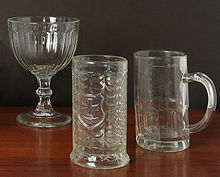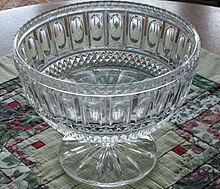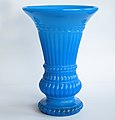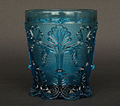Pressed glass
Pressed glass is pressed in mechanized processes glass . As a rule, the liquid glass is blown into a mold beforehand, but there is also pure pressing. Industrially produced pressed glass has been around since the beginning of the 19th century.
Traditional blow molding

Blown glass is known from antiquity. In more recent times, blowing into a mold was not only a technical simplification, but also offered the possibility of producing glasses of the same shape and size. This method was common practice in all European and American glassworks.
The molds, mostly divided in two halves, were made of wood and were opened after the glass had been inflated. In the case of rotationally symmetrical shapes, the glassblower was able to turn the part continuously with the help of the previously watered wooden shape so that the glass was as round and smooth as possible. The surface of glasses that could not be rotated due to their shape, for example, was smoothed by reheating in a glass furnace.
Development of pressed glass
Mechanized production
The first production lines were apparently developed simultaneously near Boston in 1825 and 1828 by two New England glassworks - the New England Glass Company in Cambridge and the Sandwich Glass Company in Sandwich . The decisive step was attributed to Deming Jarves in Sandwich. His glass factory in particular was known for its pressed glass.
The air piston or compressed air and above all the hand lever press invented in the 1820s were of particular importance for the industrial production of pressed glass. Because the glasses could no longer be rotated, the wooden molds, which were prone to wear and tear, were soon switched to metal molds. The mold usually bears a pattern, while the stamp that presses the glass against the wall of the mold is smooth or even. When blowing in with compressed air, the inner surface is also smooth, but follows the outer shape of the glass. The multi-part press molds leave visible press seams on the outside of the finished product.
Pressed glass has a duller surface and softer contours than cut glass. These disadvantages were initially offset by "grained" patterns - countless small raised points and the resulting refractions - which also concealed unevenness in the glass. From around 1840, pressed glasses were given their shine through a “ fire polish ”.
Utility glass for everyone
Industrial mass production also earned pressed glass the nickname “poor people's glass”. For example, all kinds of drinking mugs, beer glasses, plates, glass bowls, cans and glass roof tiles were manufactured. Around 1870 people began to imitate the precious and expensive European crystal cut glass , e.g. B. Foot mug in the style of the Bohemian Biedermeier. In the 1880s and 1890s, the Vallérystal glassworks in Alsace-Lorraine mainly included cans with animal and plant motifs in its pressing program.
The Art Deco era after the First World War was dominated by simple shapes and decors reduced to colored surfaces and lines. One type of ornament that was used in the 1930s in particular for vases and similar objects was oralite (also known as agate art glass, marble glass, in English-speaking countries cloud glass or slag glass).
Pressed glass today
literature
- Marlene Reidel : happiness with glass. From the beer bottle to the magnificent vase. Mosak-Verlag, Grafenau 1988, ISBN 3-87553-325-9 , p. 102.






